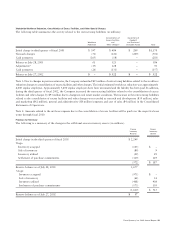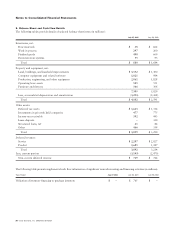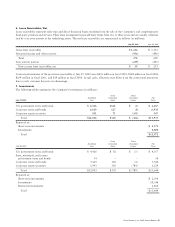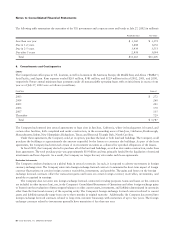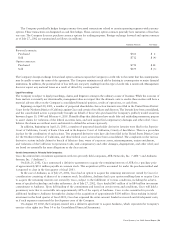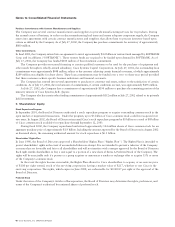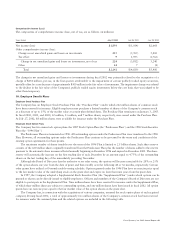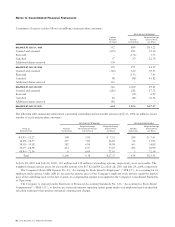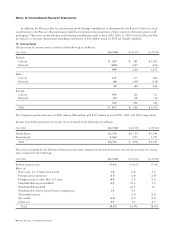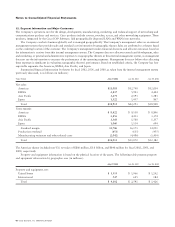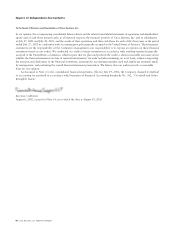Cisco 2002 Annual Report Download - page 47
Download and view the complete annual report
Please find page 47 of the 2002 Cisco annual report below. You can navigate through the pages in the report by either clicking on the pages listed below, or by using the keyword search tool below to find specific information within the annual report.
Cisco Systems, Inc. 2002 Annual Report 45
U.S. income taxes and foreign withholding taxes were not provided for on a cumulative total of $1.2 billion of undistributed
earnings for certain non-U.S. subsidiaries. The Company intends to reinvest these earnings indefinitely in operations outside the
United States.
The components of the deferred tax assets (liabilities) are as follows (in millions):
July 27, 2002 July 28, 2001
ASSETS
Allowance for doubtful accounts and returns $ 247 $ 466
Lease reserves 281 325
Loan reserves 249 284
Inventory allowances and capitalization 340 706
Investment reserves 476 274
In-process R&D, goodwill, and purchased intangible assets 436 400
Deferred revenue 968 478
Credits and net operating loss carryforwards 391 414
Other 497 230
Total deferred tax assets 3,885 3,577
LIABILITIES
Purchased intangible assets (192) (266)
Unrealized gains on investments – (1)
Other – (187)
Total deferred tax liabilities (192) (454)
Total $3,693 $ 3,123
The following table presents the breakdown between current and non-current deferred tax assets (in millions):
July 27, 2002 July 28, 2001
Current $ 2,030 $ 1,809
Non-current 1,663 1,314
Total $ 3,693 $ 3,123
The non-current portion of the deferred tax assets is included in other assets.
At July 29, 2000, the Company provided a valuation allowance on certain of its deferred tax assets because of uncertainty
regarding their realizability due to expectation of future employee stock option exercises. As of July 28, 2001, the Company had
removed the valuation allowance because it believed it was more likely than not that all deferred tax assets would be realized in
the foreseeable future and was reflected as a credit to shareholders’ equity.
As of July 27, 2002, the Company’s federal and state net operating loss carryforwards for income tax purposes were $83 million
and $14 million, respectively. If not utilized, the federal net operating loss carryforwards will begin to expire in fiscal 2010 and
the state net operating loss carryforwards will begin to expire in fiscal 2003. As of July 27, 2002, the Company’s federal and state
tax credit carryforwards for income tax purposes were $255 million and $164 million, respectively. If not utilized, the federal
tax credit carryforwards will begin to expire in fiscal 2005 and state tax credit carryforwards will begin to expire in fiscal 2003.
The Company’s income taxes payable for federal, state, and foreign purposes have been reduced, and the deferred tax assets
increased, by the tax benefits associated with dispositions of employee stock options. The Company receives an income tax benefit
calculated as the difference between the fair market value of the stock issued at the time of exercise and the option price, tax
effected. These benefits were credited directly to shareholders’ equity and amounted to $61 million, $1.8 billion, and $3.1 billion
in fiscal 2002, 2001, and 2000, respectively. Benefits reducing taxes payable amounted to $61 million, $1.4 billion, and $2.5 billion
in fiscal 2002, 2001, and 2000, respectively. Benefits increasing gross deferred tax assets amounted to $358 million and $582 million
in fiscal 2001 and 2000, respectively.
The Company’s federal income tax returns for fiscal years ended July 31, 1999 and July 25, 1998 are under examination and
the Internal Revenue Service has proposed certain adjustments. Management believes that adequate amounts have been reserved
for any adjustments that may ultimately result from these examinations.


